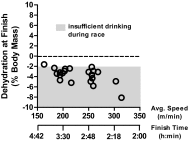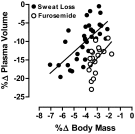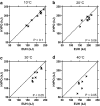Hypohydration and Human Performance: Impact of Environment and Physiological Mechanisms
- PMID: 26553489
- PMCID: PMC4672008
- DOI: 10.1007/s40279-015-0395-7
Hypohydration and Human Performance: Impact of Environment and Physiological Mechanisms
Abstract
Body water losses of >2 % of body mass are defined as hypohydration and can occur from sweat loss and/or diuresis from both cold and altitude exposure. Hypohydration elicits intracellular and extracellular water loss proportionate to water and solute deficits. Iso-osmotic hypovolemia (from cold and high-altitude exposure) results in greater plasma loss for a given water deficit than hypertonic hypovolemia from sweat loss. Hypohydration does not impair submaximal intensity aerobic performance in cold-cool environments, sometimes impairs aerobic performance in temperate environments, and usually impairs aerobic performance in warm-hot environments. Hypohydration begins to impair aerobic performance when skin temperatures exceed 27 °C, and with each additional 1 °C elevation in skin temperature there is a further 1.5 % impairment. Hypohydration has an additive effect on impairing aerobic performance in warm-hot high-altitude environments. A commonality of absolute hypovolemia (from plasma volume loss) combined with relative hypovolemia (from tissue vasodilation) is present when aerobic performance is impaired. The decrement in aerobic exercise performance due to hypohydration is likely due to multiple physiological mechanisms, including cardiovascular strain acting as the 'lynchpin', elevated tissue temperatures, and metabolic changes which are all integrated through the CNS to reduce motor drive to skeletal muscles.
Figures








References
-
- Sawka MN, Wenger CB, Pandolf KB. Thermoregulatory responses to acute exercise-heat stress and heat acclimation. In: Fregly MJ, Blatteis CM, editors. Handbook of physiology, section 4, environmental physiology. New York: Oxford University Press; 1996. pp. 157–185.
-
- Freund BJ, Young AJ. Environmental influences body fluid balance during exercise:cold exposure. In: Buskirk ER, Puhl SM, editors. Body fluid balance: exercise and sport. New York: CRC Press; 1996. pp. 159–181.
-
- Hoyt RW, Honig A. Body fluid and energy metabolism at high altitude. In: Am. Physiol. Soc., editor. Handbook of physiology: environmental physiology. Bethesda; 1996. p. 1277–89.
-
- Sawka MN. Body fluid responses and hypohydration during exercise-heat stress. In: Pandolf KB, Sawka MN, Gonzalez RR, editors. Human performance physiology and environmental medicine at terrestrial extremes. Indianapolis: Cooper Publishing Group; 1988. pp. 227–266.
-
- Mack GW, Nadel ER. Body fluid balance during heat stress in humans. In: Fregly MJ, Blatteis CM, editors. Handbook of physiology: environmental physiology. New York: Oxford University Press; 1996. pp. 187–214.
Publication types
MeSH terms
LinkOut - more resources
Full Text Sources
Other Literature Sources
Medical

